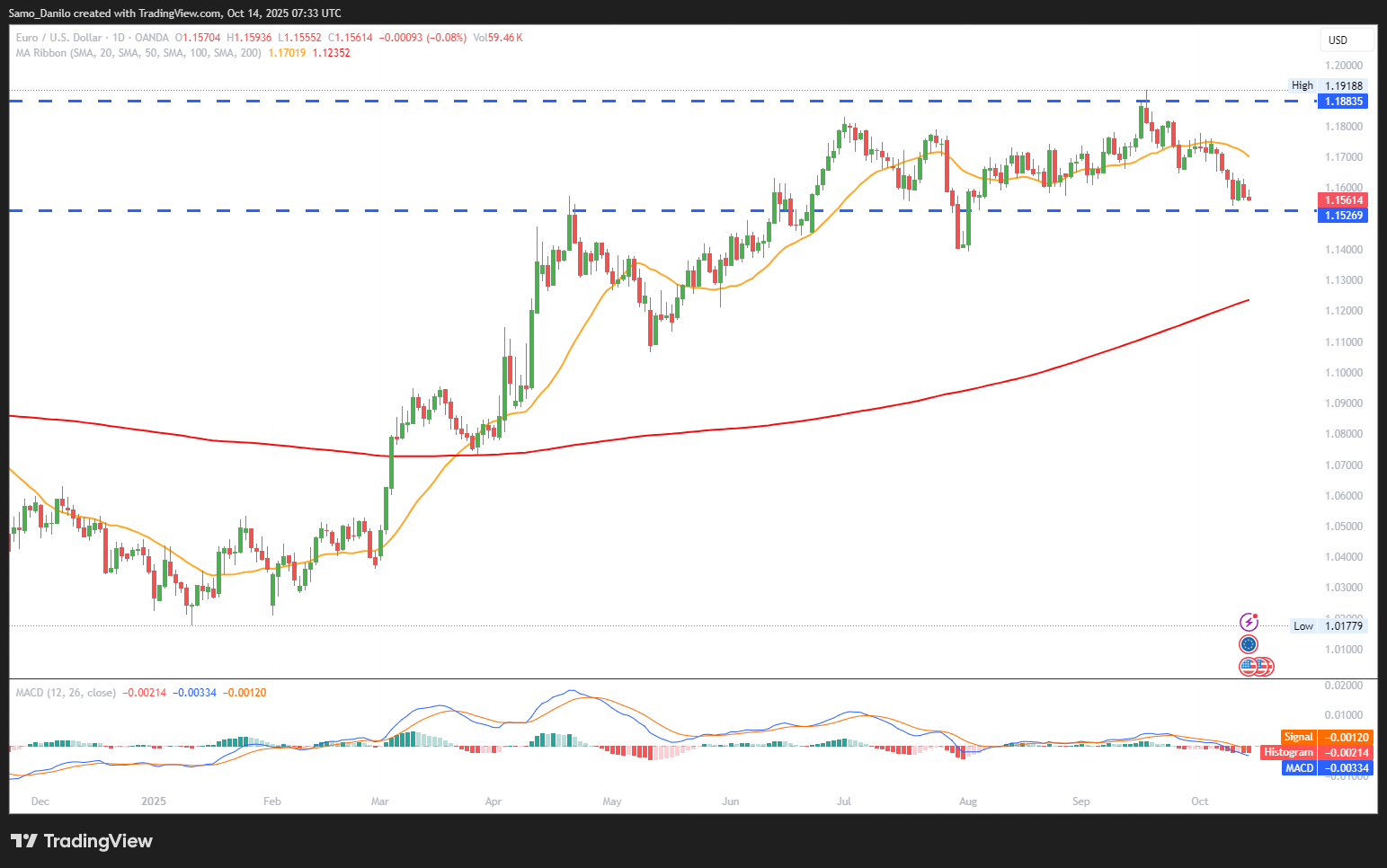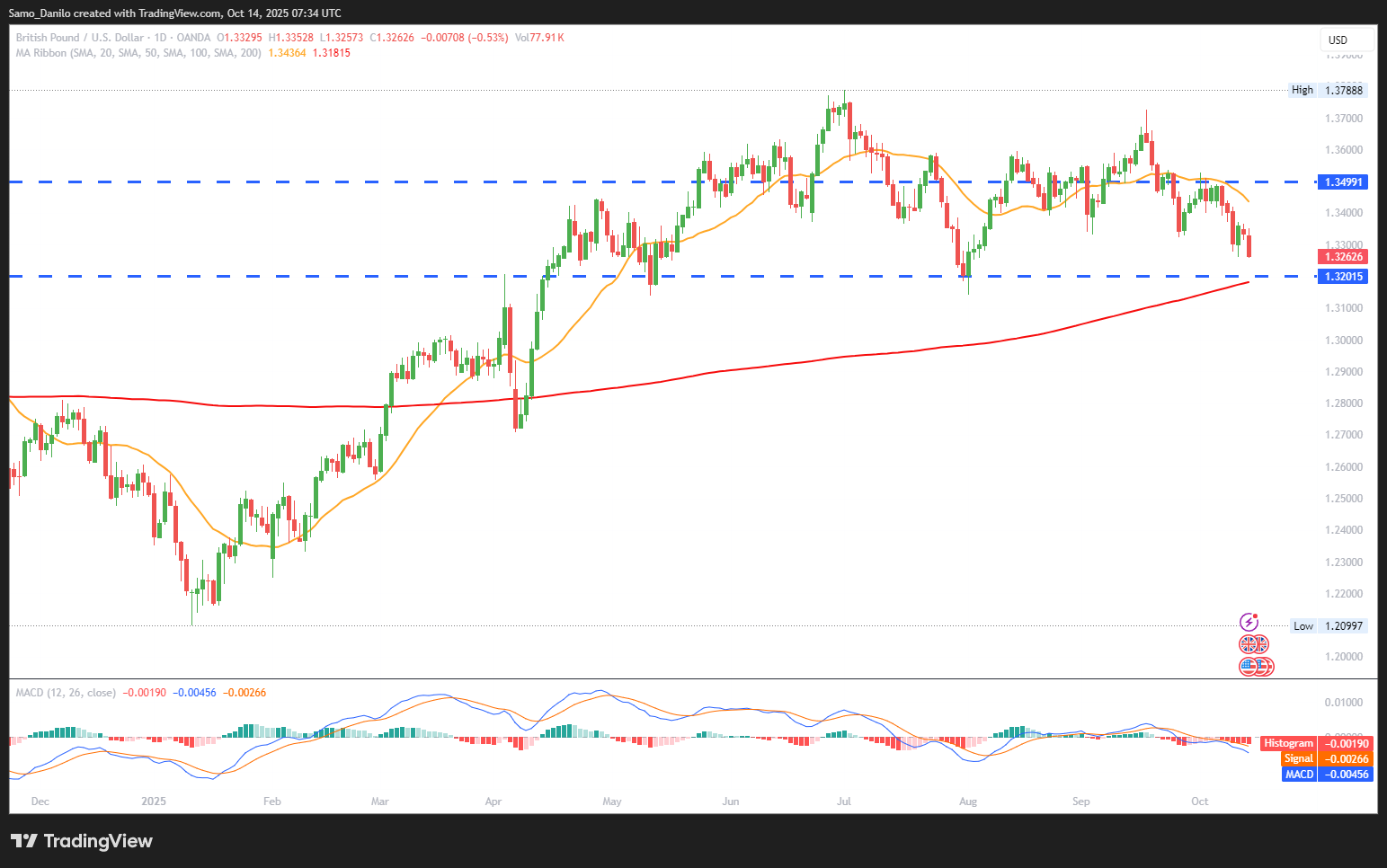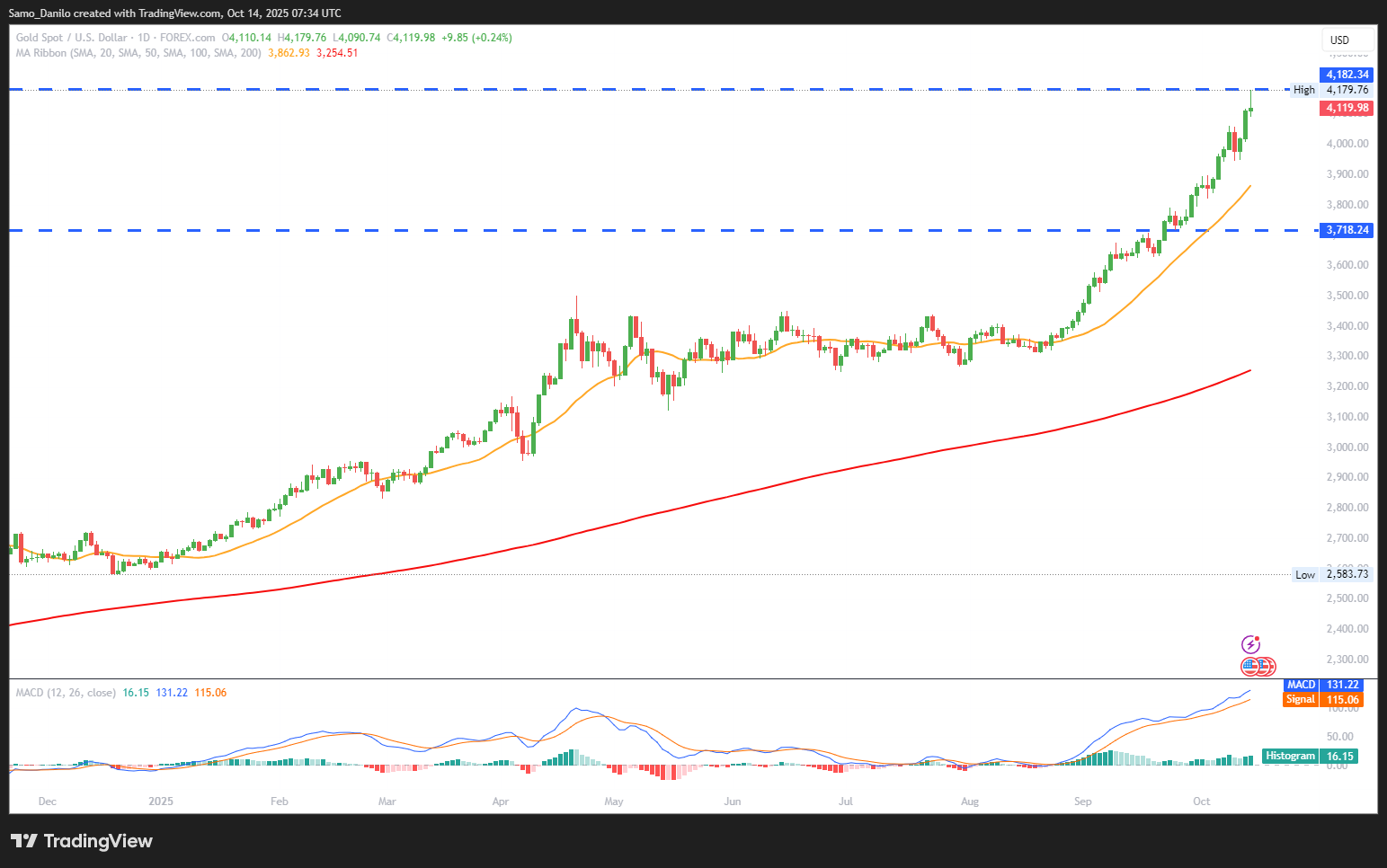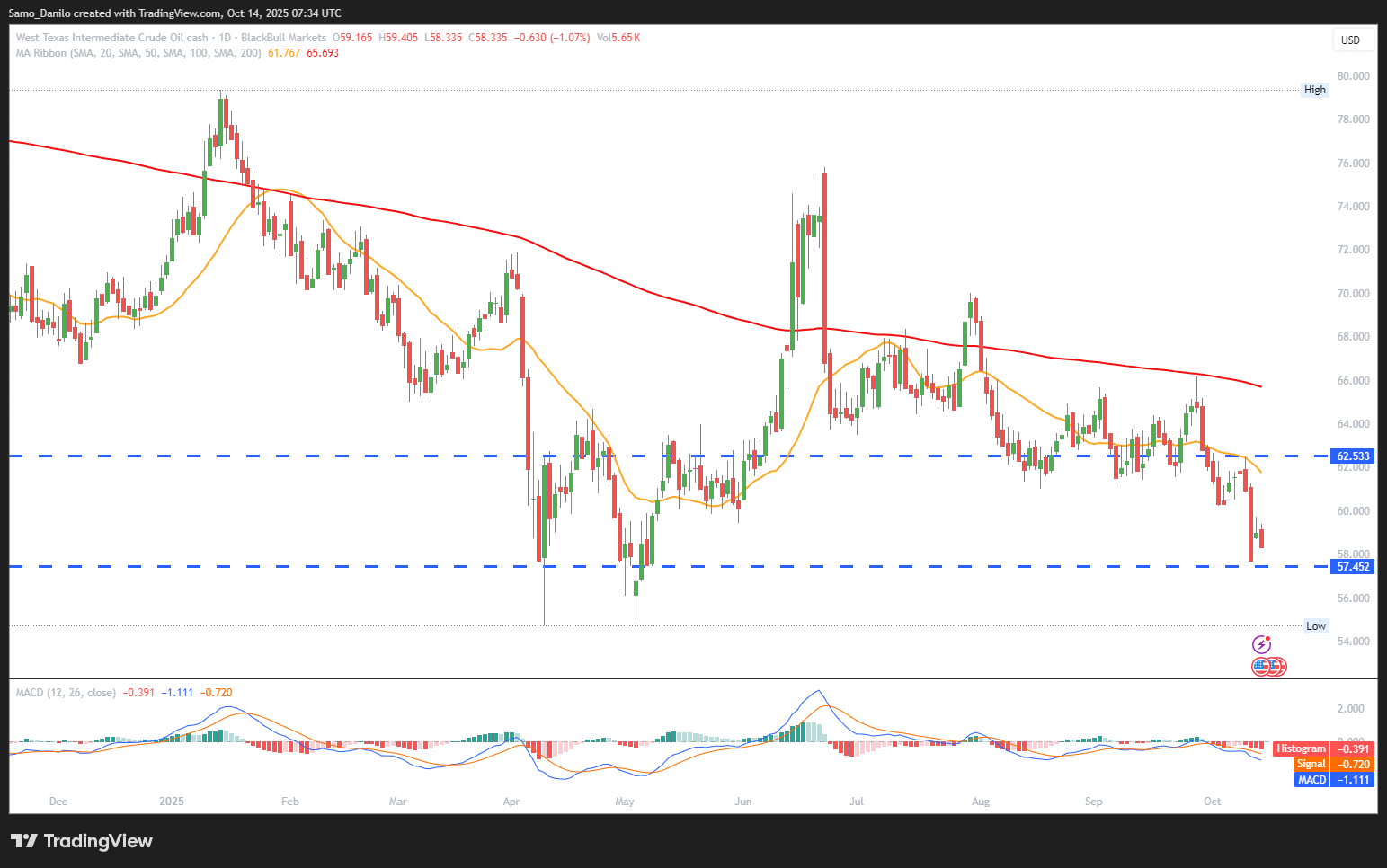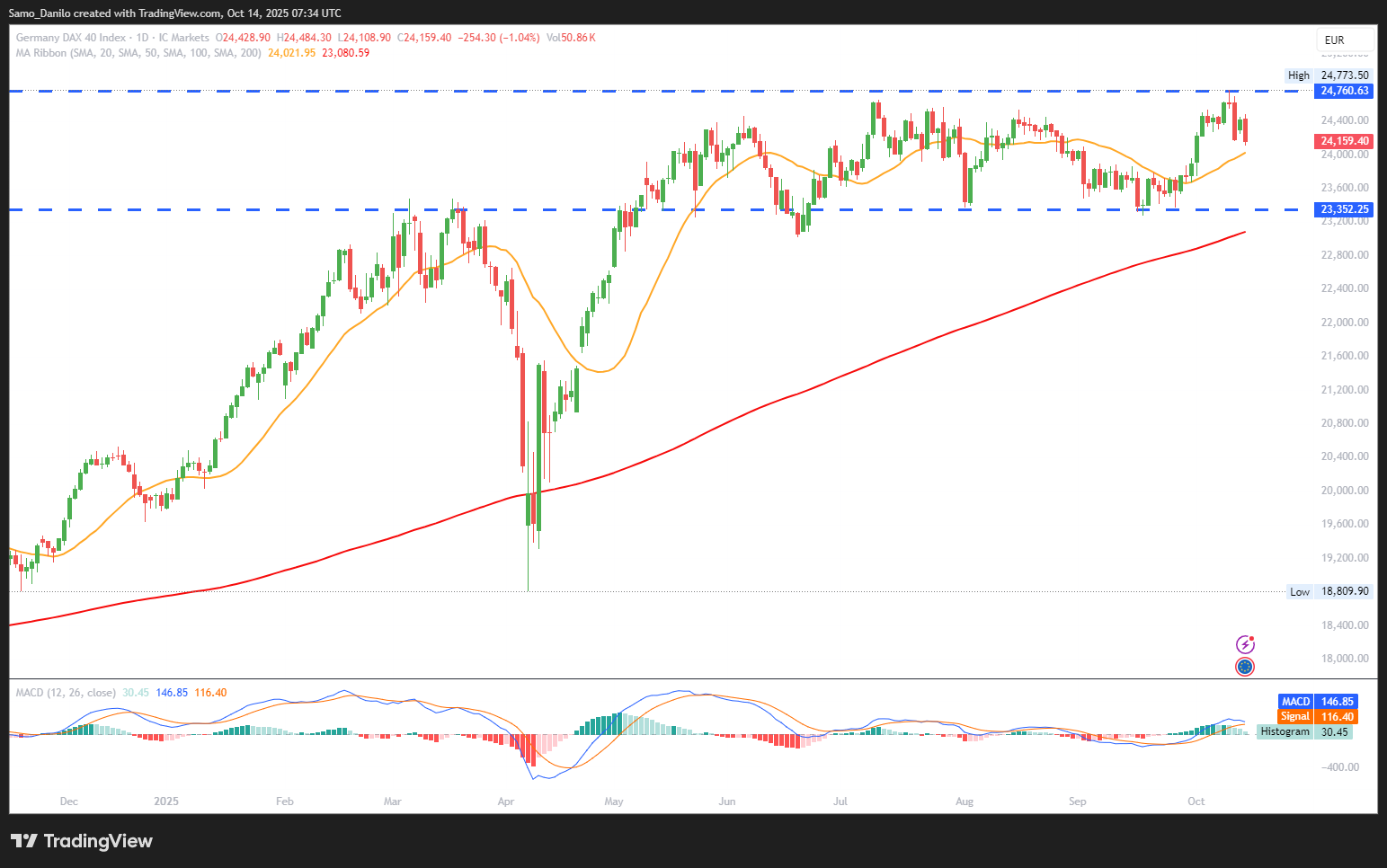EURUSD
- EUR/USD Price: The EUR/USD pair edged slightly higher to 1.1580 after suffering a 0.5% loss in the previous session. The modest rebound indicates short-term stabilization, though overall sentiment remains cautious.
- Political Uncertainty: Opposition leaders Le Pen and Ciotti have filed a no-confidence motion against PM Lecornu’s government. This political tension could undermine confidence in the euro and weigh on market stability.
- Fiscal Measures: The upcoming French budget aims to cut €31B in costs and raise €14B in new revenue, targeting wealthy holding structures. While fiscally responsible, austerity signals could temper domestic growth expectations, potentially limiting euro strength.
- Fed Commentary: Philadelphia Fed’s Anna Paulson emphasized that risks to the labor market justify further rate cuts, especially as tariffs’ inflationary impact appears limited. The dovish sentiment pressures the USD, offering some upside support to EUR/USD.
- Geopolitical Context: President Zelenskiy’s upcoming talks with U.S. leadership on defense and energy suggest ongoing geopolitical uncertainty. While not directly impacting EUR/USD immediately, sustained U.S. engagement in global affairs could influence overall dollar flows.
Closing statement: EUR/USD is attempting to stabilize amid U.S. dovish signals and European political noise. Short-term direction leans slightly bullish toward 1.16, but sustained gains may be capped unless French political risks ease and broader eurozone fundamentals improve.
GBPUSD
- GBP/USD Price: The GBP/USD pair fell below 1.3300 during the European session, marking continued weakness in the pound. Selling momentum reflects persistent bearish sentiment amid soft domestic data and market caution.
- Labor Market: The UK unemployment rate rose to 4.8% in September, with the claimant count climbing to 25.8K. The rise in joblessness signals early cracks in labor market resilience, pressuring the pound as growth concerns resurface.
- Political Concerns: UK Security Minister Jarvis expressed grave concerns about institutional security amid a high-profile China-related case. While not directly economic, heightened geopolitical or intelligence-related tensions may erode investor confidence in UK assets.
- BoE Commentary: MPC member Greene noted that economic activity and wage growth are stronger than anticipated a year ago, reinforcing her hawkish stance. However, with slowing labor data, markets remain uncertain about the Bank of England’s policy direction.
- CB Speeches: Markets are awaiting comments from MPC member Alan Taylor and Governor Andrew Bailey for further policy clues. Any dovish tones could intensify pressure on the pound, while reaffirmed hawkishness might offer short-lived relief.
Closing statement: GBP/USD remains under selling pressure as weak labor data contrasts with the BoE’s cautious optimism. The near-term outlook leans bearish, with potential dips toward 1.3250 unless upcoming BoE communications provide a clearer, more supportive tone for sterling.
XAUUSD
- XAU/USD Price: Gold prices retreated sharply from a new all-time high, now trading near $4,100. The move reflects profit-taking and fading momentum after a strong rally, though overall sentiment remains broadly bullish.
- Trade Tensions: Renewed U.S.-China trade friction, particularly around rare earth export controls, fueled early volatility in Asian markets. Ongoing uncertainty supports gold’s safe-haven appeal, though temporary easing efforts from both sides may limit immediate upside.
- Government Shutdown: With the shutdown stretching into its thirteenth day, investor anxiety has increased, sustaining underlying demand for gold. However, lack of progress may also cap liquidity and create short-term swings as traders await fiscal clarity.
- Geopolitical Overtures: President Trump’s remarks on potential peace with Iran and regional harmony in the Middle East provided a brief risk-on impulse. This slightly reduced geopolitical demand for gold, contributing to its current consolidation phase.
- Fed Speeches: Multiple Fed officials, including Chair Powell, are set to speak later in the day, with recent signals pointing more dovish. Should their tone confirm easing bias, gold may regain traction as lower rate expectations weaken the dollar.
Closing statement: XAU/USD is consolidating after a record-setting rally, as profit-taking and geopolitical moderation weigh on momentum. Near-term direction hinges on Fed communication — a dovish message could reignite bullish pressure, potentially pushing gold back toward $4,200.
CRUDE OIL
- Crude Oil Price: West Texas Intermediate (WTI) crude slipped to around $58.45 per barrel in early European trading, down from $59.20. The decline reflects mild selling pressure as traders weigh global supply dynamics against geopolitical uncertainty.
- Ukraine-Russia Conflict: Ukrainian drone strikes on Crimean oil infrastructure and Russian bombings in Kharkiv highlight growing regional instability. While typically bullish for oil, markets appear to be discounting prolonged conflict risks amid broader macroeconomic concerns.
- Arms Supply: President Trump’s hesitation over providing Tomahawk missiles to Ukraine introduces policy uncertainty. The cautious stance tempers fears of immediate escalation, slightly easing geopolitical risk premiums in oil pricing.
- OPEC+ Outlook: OPEC+’s latest report projects a narrowing supply deficit by 2026 as planned output expansions continue. This forward-looking guidance reinforces expectations of gradual supply normalization, adding downward pressure to oil in the medium term.
- Trade Signals: China’s exports surged 8.3% globally but dropped 27% to the U.S., underscoring uneven global demand recovery. The strong overall export data suggests stable energy consumption ahead, though U.S.-China trade weakness could limit price gains.
Closing statement: Crude oil prices are softening amid geopolitical volatility and OPEC+’s longer-term production outlook. Near-term momentum leans bearish toward the $58 mark, though escalating conflict or dovish Fed signals could provide intermittent support for WTI.
DAX
- DAX Price: The DAX is trading around 24,175 points, down 0.98%, reflecting broad risk-off sentiment in European markets. The decline indicates investor caution amid mixed economic and geopolitical signals.
- Inflation Update: Germany’s September final CPI matched expectations at 2.4% y/y, while core inflation rose to 2.8% from 2.5%. Rising core inflation may prompt market concerns over potential monetary tightening, affecting equity valuations.
- Current Account: Germany’s current account surplus dropped from €14.8B to €8.3B in August. A shrinking surplus can signal weaker net exports and slower domestic savings, potentially weighing on investor sentiment.
- Earnings Season: Investors are cautious ahead of major U.S. financial sector earnings from banks like JPMorgan and Goldman Sachs. The outcome of these reports could influence global market risk appetite and, by extension, European indices like the DAX.
- Trade Tensions: China reaffirmed its firm stance in the trade and tariff dispute with the U.S., while keeping negotiations open. Persistent trade uncertainty adds pressure to export-sensitive sectors in Germany, influencing the index negatively.
Closing statement: The DAX is experiencing short-term weakness amid domestic inflation concerns, current account contraction, and global trade uncertainty. Market direction will likely hinge on U.S. earnings outcomes and developments in Sino-American trade negotiations, with potential for volatility in the coming sessions.
